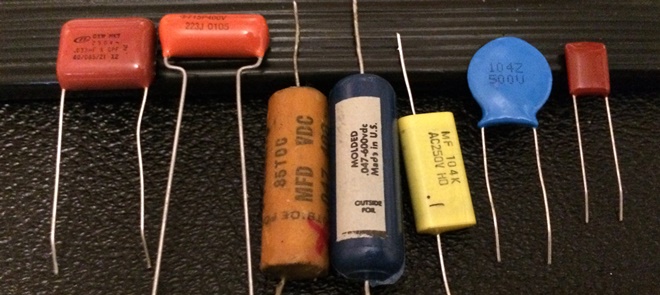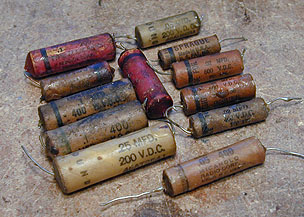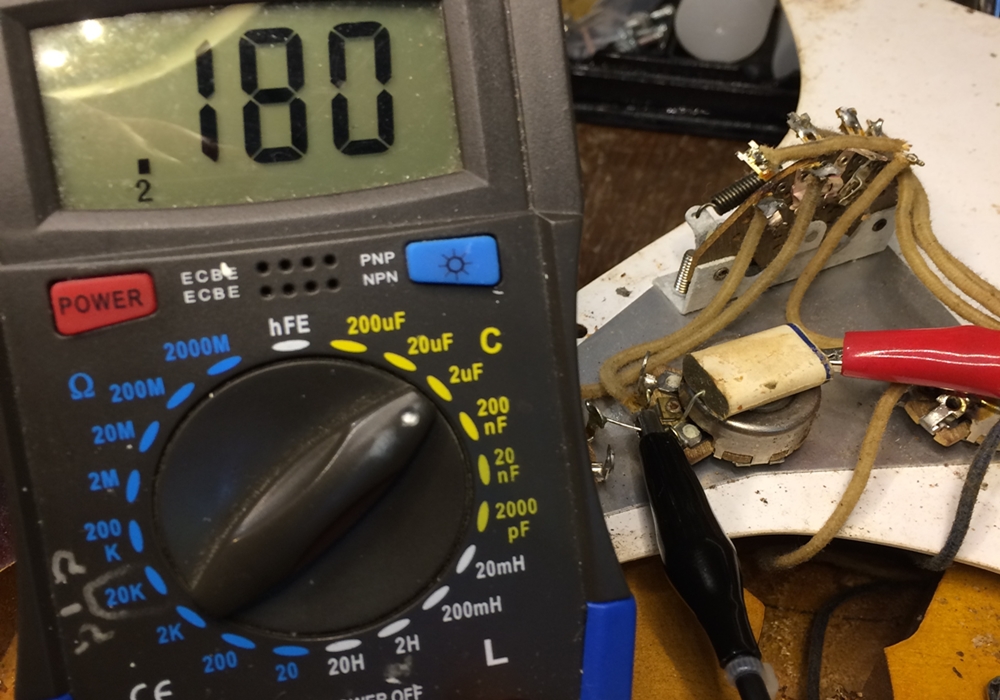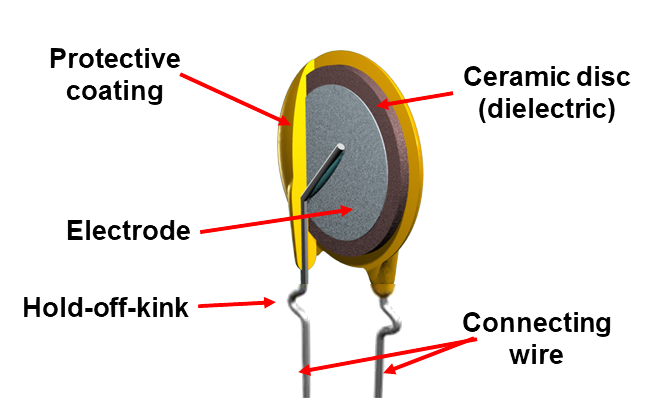Your Cart is Empty
NOW FREE SHIPPING TO 48 CONTIGUOUS UNITED STATES ON ALL ORDERS!!!
Capacitors: What You Need to Know about The Differences in Guitar Tone Caps
by vaughn skow June 28, 2019 5 min read
Wow! This blog really began many months back with THIS BLOG on Tone Cap VALUES, which are very important, so read that blog first if you have not yet! Y'all know that I sometimes get a little more long-winded than necessary, so if ya want to jump right to the point here it is: Don't waste your money on caps that are very expensive, any good quality non-polar cap will work PERFECT as a guitar tone cap. As a general rule, any cap that costs more than a buck or two is as good as it gets. Want more? Then read on!

The lore, the legend, and the myths:
Wonderful, mythical, great sounding vintage Fender guitars from the golden era mostly contained foil & wax-paper caps often called "phone book" caps. Gibson's from the golden era usually had oil-filled paper and foil caps "bumble bees" or "black beauties". Since these are the guitars that folks now go crazy over, folks also sometimes place mythical value on those old cap types. Sorry for busting some of y'all's bubble, but that's ...um ... downright stupid.
They used those caps because it's what was available, period.
The Truth:
These old caps are totally unstable and drift like mad! The wax and oil drys up over time and the caps turn into ...well, whatever they want. Usually as these caps age they drift UP in capacitance value, rarely they drift down, sometimes they short, and sometimes they turn to nothing, an "open circuit". Whew! Wonder why two 1957 Strats or LesPauls NEVER sound exactly alike? Here's one reason!
EVERY shop that works on old tube-era equipment has piles and piles of old paper and oil caps around the shop. As a general rule, when you are restoring a piece of tube equipment you don't even wast time checking them, you just replace them because you KNOW they will be bad, or at least badly out of spec. Mythical: no. Crappy: yes!

I just sold a particularly sweeeet sounding 1959 Strat. She was one of the warmest and best sounding Strats I'd ever heard. As part of the selling process, I catalogued and authenticated all of the components. When I measured the tone cap it became clear that was part of it's warm tone:

Yep, that .1uf cap had drifted all the way up to nearly TWICE it's original value, .18uf! I imagine if we check it in another decade or so it will be up to more than twice it's original value, and eventually it will fail entirely. Hey, it sounded great, but do we REALLY want a cap that drifts around that much? Not me. The paper type caps are particularly susceptible to humidity and temperature related drift. Here in the humid deep south they tend to drift up, but in a dry climate they might drift down, and in a very hot climate (or storage) they may melt and totally fail. The oil-filled caps are not quite as bad as the wax-paper caps, but they certainly are a long way from stable over time.
Here is what both Wax paper and foil as well as paper in oil caps look like inside, in one case it's simply wax paper rolled up with foil, and in the other it's brown (Kraft) paper rolled up with foil and then bathed in a drop or so of oil. Nothing magic here, and lots to go wrong over time.

The Solution:
Okay, first a disclaimer: If you have a vintage instrument that sounds good, for God's sake leave the original factory cap in there; not because it sounds better, because the guitar's worth more when it's original. Apart from that the solution is easy: use high quality, modern caps with tight tolerances and good stability. Personally, I am a fan of the very cap that Fender switched to as soon as they became available (and still use today in all mid to high end guitars): the ceramic disc cap. These things are dead-simple but they are amazingly stable and unaffected by the forces of time.

Just a thin wafer of ceramic/dielectric material with a lead on each side and the whole thing sealed up tight in a protective coating (like enamel). There is only one real down side to the ceramic cap, they can't easily be made to have high capacitance values ... a micro-farad or two is as high as you'll find these, which is totally a non-issue in guitar caps which pretty much never exceed 0.1uf!
Some final thoughts:
I've been a part of numerous listening tests where players tried to tell the difference between different guitar tone caps of the exact same measured capacitance value and NEVER has anyone been able to tell any difference. That actually makes great sense as a passive guitar cap is merely shunting a portion of a TINY electric signal of a few thousandths of a volt to ground, child's play for any decent cap! Again, remember I said various caps of identical measured value; indeed, folks with good ears can easily tell a .022uf from a .1uf!
I think paying a hundred bucks or so for Gibson bumblebee repros, or Allesandro phonebook repros for a modern guitar is ridiculous. However, if I were restoring a valuable vintage instrument that had long ago had it's original cap(s) replaced (probably because they went bad), then yep ... I'd put the best repro in there I could to add value to the instrument. For anybody else I'd say this:
- Use the proper VALUE of capacitance (don't worry about voltage, they can ALL handle a guitar's level)
- Use high-quality caps.
- Use only non-polarized caps. Some polarized caps like Tantalum sound just fine, but who wants to keep up with which lead is +/- if ya don't have to?
And last I thought I'd share this hilarious exchange from the My Les Paul forum:
OP: Which way does the outer foil in a capacitor go towards? Does it point to the volume or point toward the tone pot?
A1: One lead goes to the middle lug of the volume pot and the other lead goes to the outer lug of the tone pot. (DUH!)
A2: Outer foil should always be oriented toward Virgo, so plan to change your playing position seasonally.
A3: There are circuits where placing outer foil to the ground side may matter, but this application is far outside of that realm, so there is no such thing as a theoretical correct way to orient a cap in this circuit. Both theoretically and practically, either way is equally correct. If you wish to follow this simply for peace of mind though, outer foil toward ground, meaning outer foil toward the tone pot. It really doesn't make any difference here though.
OP: What I find EXTREMELY interesting is that on the original Gibbys like the '59s all in this thread... ALL of the oil-filled Bumblebees have the outer foil connected to the TONE pot. As I was waiting for an answer here to my post I noticed this little point! I think that's very very very interesting!!! All the 1959 Les Pauls using oil-filled Bumblebees have the sealed side outer foil towards the tone pot!
So there ya have it folks!
All those mythical 59 Les Pauls got it wrong! Ya get my point? :-)
Leave a comment
Comments will be approved before showing up.
